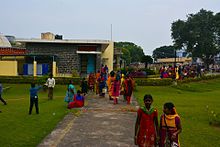Archaeological Museum in Andhra Pradesh, India
 Amaravathi Archeology Museum Amaravathi Archeology Museum | |
| Location | Amaravati, Andhra Pradesh, India |
|---|---|
| Coordinates | 16°34′28″N 80°21′29″E / 16.5745°N 80.3581°E / 16.5745; 80.3581 |
| Type | Archaeological Museum |
The Amaravathi Archaeological Museum is a museum located in, a village in of the Indian state of Andhra Pradesh. It features an impressive collection of relics that span thousands of years, primarily reflecting the region's history from the 3rd century B.C. It houses sculptures from the Mahachaitya (the Giant Stupa), providing insights into ancient Buddhist art and culture. It includes a model of the reconstructed Mahachaitya in its courtyard. Visitors can explore various galleries that showcase significant artifacts, including life-size Buddha statues and intricate carvings, representing the rich artistic traditions of Amaravathi.
History of the Museum
The Archaeological Museum in Amaravati houses a wealth of relics dating back thousands of years, unearthed through extensive excavations. Its collections reflect the rich history of Amaravati, particularly from the 3rd century B.C., including sculptures that were part of the Mahachaitya (the Giant Stupa). The site was first discovered by Colonel Mackenzie in the late 18th and early 19th centuries, leading to significant archaeological efforts by Smith and Elliot (1985), Sewell (1877), James Burgess (1881), and Alexander Rea (1888-89, 1905-06, 08-09) to uncover sculptural remains. In the post-independence period, further excavations were carried out by Subramaniyam and Krishnamurthy (1958-59), Karthikeya Sharma (1974-75) in Amaravati, and Venkataramayya and Raghavachary (1962-65) in Dharanikota, enhancing the understanding of the architectural and historical significance of the Mahachaitya and the Dharanikota citadel.
Galleries in the Museum
The Key Gallery presents important examples of Amaravati's artistic traditions. The lotus and Puranakumbha motifs symbolize auspiciousness and abundance. Two drum slabs in bas relief illustrate the structure of stupas, while the early representation of Buddha is depicted symbolically, including a "Svastika" on a cushioned seat beneath the Bodhi tree. Notably, the life-size standing Buddha, dated to the 8th century A.D., is a significant piece in this gallery.
Gallery II features a life-size standing image of Buddha characterized by the Maha Purusha Lakshanas (Marks of a Great Man). Among the remarkable pieces, a beautifully carved round panel depicts the episode of Rahula's presentation to Buddha by his father, King Suddhodana. This gallery also includes drum and dome slabs related to stupa worship, alongside various antiquities like gold coins and beads from that period.
Gallery III showcases sculptures from the 2nd century B.C., including a Yakshi of Bharhut tradition, a stele with labeled panels, and a fragment of Asoka's pillar edict. Other notable exhibits include images of Buddha from Alluru, the Dharma Chakra from Lingarajapalli, Bodhisattvas, and a dome slab representing the Three Jewels of Buddhism (Buddha, Dharma, and Sangha) through a Bodhi tree and stupas. The centerpiece is a couple in round, exemplifying the vitality of Amaravati art during the Satavahana period. Additionally, the life-size Nandishwara (bull) from the same period is a highlight of this gallery.
The museum's courtyard features a model of the stupa and reconstructed railing, illustrating key moments such as Gautama Siddhartha's departure, the return of the horse Kanthaka, and the story of Nalagiri, the royal elephant of Ajata Satru. The courtyard displays panels depicting female devotees worshipping Buddha's feet, alongside Jataka tales like Mandhata Chaddanta, Vessantara, and Losaka. Notable pieces include earlier representations of Ganesa and Ganesani and a panel illustrating the division of Buddha's relics among disputing princes.
Gallery
See also
References
- "Renewed pitch to get back 300 BC Buddhist relics from TN". The New Indian Express. 21 November 2016. Retrieved 11 October 2024.
- Howes, Jennifer (2002). "Colin Mackenzie and the Stupa at Amaravati". South Asian Studies. 18 (1): 53–65. doi:10.1080/02666030.2002.9628607. S2CID 194108928.
- "Amaravati sculptures - a colonial voyage". The Hindu. 7 April 2016. ISSN 0971-751X. Retrieved 11 October 2024.
- Shimada, Akira (2012). Early Buddhist Architecture in Context: The Great Stupa at Amaravati (ca. 300 BCE-300 CE). BRILL. p. 90. ISBN 9789004233263.
- Burgess, James (1882). Notes On The Amaravati Stupa. USA: Kessinger Publishing. ISBN 978-1167039881.
- Jane, Sinduja (1 March 2020). "Bringing the Amaravati Marbles out of shadows". The New Indian Express. Retrieved 11 October 2024.
- Singh, Lipika (2006). The World of Buddhism. Shubhi Publications. p. 10. ISBN 978-81-8290-048-6.
- "Amaravathi Archaeological Museum". Official website Guntur District. National Informatics Centre. Archived from the original on 10 March 2016. Retrieved 12 March 2016.
- ^ Museum, Archeology. Archeology Museum Amaravathi (Information Booklet). Amaravathi: Archeology Survey of India.
- Chandra Rao, Dr. P. Purna (2023). Chronicle of Guntur District Tourism (1 ed.). Guntur: Acharya Nagarjuna University. p. 21.




